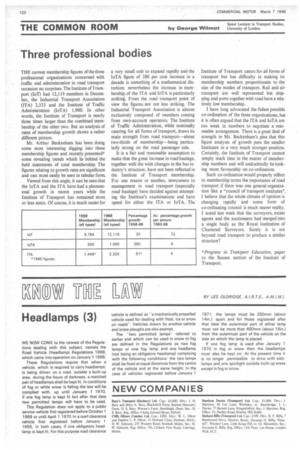Three professional bodies
Page 124

If you've noticed an error in this article please click here to report it so we can fix it.
THE current membership figures of the three professional organizations concerned with traffic and administration in road transport occasion no surprises. The Institute of Transport (IoT) had 12,119 members in December, the Industrial Transport Association (ITA) 2,333 and the Institute of Traffic Administration (IoTA) 1,900. In other words, the Institute of Transport is nearly three times larger than the combined membership of the other two. But an analysis of rates of membership growth shows a rather different picture.
Mr. Arthur Beckenham has been doing some most interesting digging into these membership figures and recently presented* some revealing trends which lie behind the bald statements of total membersbip. The figures relating to growth rates are significant and can most easily be seen in tabular form.
Viewed from this angle, it can be seen that the IoTA and the ITA have had a phenomenal growth in recent years while the Institute of Transport has remained more or less static. Of course, it is much easier for a very small unit to expand rapidly and the IoTA figure of 380 per cent increase in a decade is something of a mathematical distortion; nevertheless the increase in membership/of the ITA and IOTA is particularly striking. From the road transport point of view the figures/are not less striking. The Industrial Transport Association is almost exclusively composed of members coming from own-account operators. The Institute of Traffic Administration, while nominally catering for all forms of transport, draws its main strength from road transport—about two-thirds of membership—being particularly strong on the road passenger side.
It is a fair and reasonable assumption to make that the great increase in road haulage, together with the wide changes in the bus industry's structure, have not been reflected in the Institute of Transport membership. For one reason or another, newcomers to management in road transport (especially road haulage) have decided against attempting the Institute's examinations and have opted for either the ITA or IoTA. The Institute of Transport caters for all forms of transport but has difficulty in making its membership numbers proportionate to the size of the modes of transport. Rail and air transport are well represented but shipping and ports together with road have a relatively low membership.
I have long advocated the fullest possible co-ordination of the three organizations, but it is often argued that the ITA and IOTA are too weak in numbers to negotiate a reasonable arrangement. There is, a great deal of strength in Mr. Beckenham's plea that this figure analysis of growth puts the smaller Institutes in a very much stronger position. Certainly, the Institute of Transport cannot simply mark time in the matter of membership numbers and will undoubtedly be looking more favourably on co-ordination.
Such co-ordination would properly reflect in membership terms the importance of road transport if there was one general organization like a "council of transport institutes". I believe that the whole climate of opinion is changing rapidly and some form of co-ordinating council is much nearer reality. I noted last week that the surveyors, estate agents and the auctioneers had merged into a single body as the Royal Institution of Chartered Surveyors. Surely it is not beyond road transport to produce a similar structure?












































































































































































